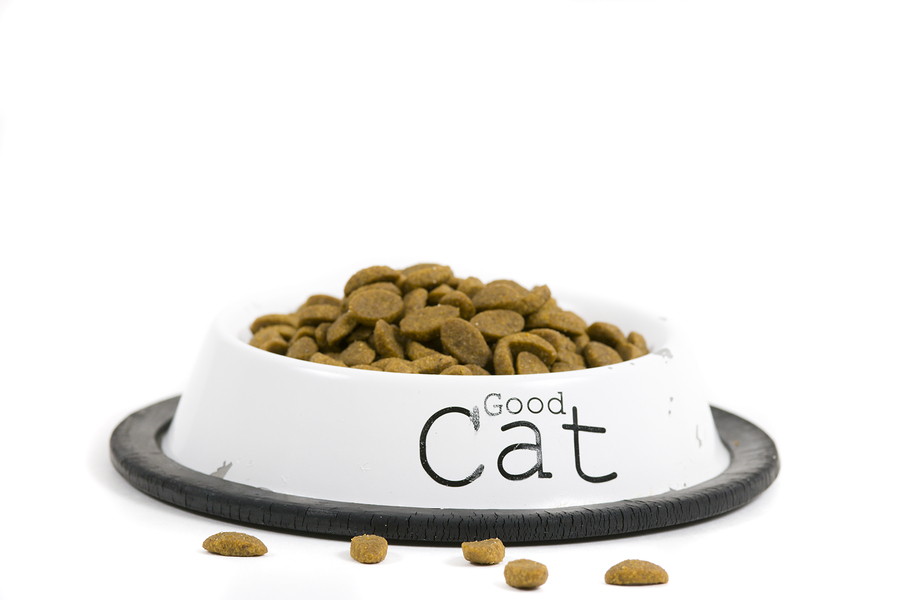This post may contain affiliate links. We are compensated for referring customers to our affiliate partners.
Feeding your pet can be a trying experience. You want to feed your cat the best quality cat food available. So many brands claim to be nutritionally sound for your cat, with fancy packaging and words like “Pro” or “Natural” and even “Grain-Free.” Some are endorsed by celebrities, some have their own theme song, and one even has its own Ginger colored spokes-cat.
As any cat food comparison will tell you; the proof is in the packaging. No, not in its color or design, but in the ingredient list found on the package. The best tool you have to give your cat the best food for his needs is the knowledge of what the ingredients are and just how they affect him.
Carnivores Don’t Eat Corn
Before domestication, cats lived in the wild and ate whatever they could catch; mice, birds, bugs, you name it. Cats did not, however, eat many fruits and vegetables unless they were first eaten by whatever rodent became the cat’s diner that night. And cats certainly did not eat corn. Yet, for some reason, cat food manufacturers have decided that corn is one of the most important ingredients that can be placed into cat food today. In fact, taking a look at many commercial cat food brands, you’ll often find corn in some form listed as the first ingredient. This means that it is the most prominent ingredient in the food. Since a cat’s digestive system is not made to digest corn products, it can cause allergic reactions or stomach upset in cats who have grain sensitivities.
Some of the most popular dry cat food brands list corn at the top of the list:
- Friskies Indoor Delights
- Purina Cat Chow Indoor Formula
- 9-Lives Daily Essentials
Not all cats have an intolerance for corn, though, so your cat might be enjoying what he’s been getting. But it really isn’t what he should be getting.
Cats Don’t Need Colors
The addition of artificial colorings and flavorings give cat food a lower quality. Most artificial flavors actually contain many chemical ingredients, not just one, and many of those chemicals are volatile. Dyes such as red, yellow, and blue are used to make cat food more appealing to pet owners, but it can cause problems in your cat from allergic reactions to hyperactivity. Both BHA & BHT are preservatives that have been banned in human foods in many countries due to cancer risks. However, they remain approved for use in pet foods. Some of the common brands that use these ingredients are:
- Whiskas Oceanfish Entrée (BHA/BHT)
- Meow Mix Seafood Medley (artificial colors/dyes)
- Fancy Feast Gourmet Savory Chicken and Turkey (dyes/artificial flavoring)
Bye-Bye By-Products
Finally, we get to the by-products. When doing a cat food comparison, there is a big difference between a specifically named by-product (such as poultry by-product or beef by-product) and an unnamed meat by-product. For example, poultry by-product is made from clean, rendered parts of poultry carcasses and can contain bones, offal and undeveloped eggs, and “non-meat” poultry products like feet, beaks, and bones. Though it may seem gross to us, cats love that stuff and at least you know it is part of a chicken. Meat by-product, however, is the lowest quality meat product that can be included in any cat food. It can contain parts of slaughtered animals including the lungs, spleen, kidneys, brain, liver, blood, bone, partially defatted low-temperature fatty tissue, and stomach and intestines. As if that isn’t bad enough, meat by-products can also legally contain animals that were dead, dying, or diseased before slaughtering. Meat by-product is an unnamed meat source and you never know for sure where it is coming from or what animals are being used. Some of the meat by-products brands include:
- Sheba Premium Pate Beef and Chicken
- IAMS Proactive Health Adult Premium Pate Turkey and Giblets
- Science Diet Adult Savory Chicken Entrée
Real Meat, Meat Meal, and the Real Deal
When doing your cat food comparison, stick with those who have real meat or meat meal (beef, chicken, fish, etc.) listed as the first ingredient. Meal is actually a good thing. For example, with chicken meal, the moisture was removed prior to cooking. That means chicken meal actually has a much higher protein percentage and provides far more beneficial nutrients to your cats than whole chicken.
If you’re looking for cat foods that are high quality and made without any corn fillers, contain zero artificial colors or flavors, skip the BHA and BHT, and contain only meat sources that are not meat by-products, try one of these brands listed below for optimum nutrition:
- Natures Variety Chicken Meal
- Solid Gold Katz-n-Flocken
- AvoDerm Salmon & Brown Rice
- Blue Buffalo Freedom Indoor Adult Fish
- Wellness Complete Health Beef Salmon Recipe
If you’ve been feeding you cat one of the not-so-good brands previously mentioned; don’t feel too bad. So many people don’t think twice about cat food. All they know is if it costs more than 99 cents a box, it should be all right to feed him. People see the flashy names, or the brands that have been around since the 1970’s, and imagine that if they’ve been around that long, they should be good. It’s only when you take the time to learn about your cat’s food that you might discover something you kind of wish you hadn’t. The good news is; the world is full of second chances and if you make the switch now, you’ll have many more healthy and happy years with your well-nourished cat. Bon appetite!



